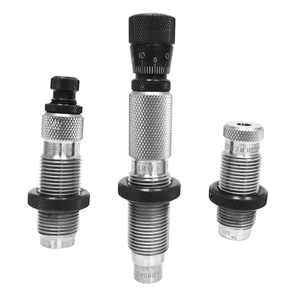
6.5-06 Redding Type S Neck Die
Redding6.5-06 Redding Type S Neck Die
Redding Type S Neck Dies are designed for those handloaders wanting to control the amount of resizing to increase the longevity of their brass, control the amount of sizing on neck turned brass and minimize the disturbance to the fired brass. Regardless of the handloader’s reason, the Type S Neck Die has been very successfully used by shooters in all of the accuracy disciplines from short range benchrest (100-yard to 200-yards), F-Class and Full-bore Shooting (out to 1000-yards typically) and ELR Events (Extreme Long Range – past 1000-yards). Conventional sizing dies, both Full Length and Neck Sizing dies have always utilized SAAMI specifications to determine how much sizing occurred. Redding’s "S" Type Neck Die utilizes neck bushings to allow the handloader to tune the amount of neck sizing to their needs.
This could reduce the amount of sizing as much as .010" which foremost eliminates a lot of oversizing or work hardening to the brass. Oversizing can also lead to concentricity issues (runout) to both the case itself and the final loaded cartridge.
Redding’s Type S Neck Die eliminates most of these problems due to its design and the use of user selected neck bushings which replace the fixed internal diameter of traditional neck dies.
Another benefit to the Type S Neck Die is that the neck sizing bushing is self-centering in the die body which helps with case neck concentricity.
Controlling neck tension and the amount of sizing is now in your hands when using the Redding Type S Neck Die.
Sizing Die Bushings are sold separately. Bushings are available in .001" increments.
The Redding Type S - Bushing Style Neck Sizing Die allows the reloader to precisely control the amount of neck sizing and bullet tension on their handloads.
Includes:
- One Redding Type S Neck Die
- Complete Decapping Rod Assembly with the correct sizing button
- One Redding decapping pin retainer (used when not choosing to use a sizing button) – This retainer is not included with .17 caliber dies
- One die box
- Complete Instructions
- Neck Sizing Bushings Sold Separately. All Dies are sold without bushings.
- Shellholder sold separately
Features:
- Ability to choose the amount of neck sizing occurring on your cases by choosing the neck sizing button based on the brass you are using
- Reduces the amount of work hardening occurring to your brass thereby extending brass life
- Use the conventional sizing button included which will size the internal diameter of your neck as you extract the case out of the die. Best when using unturned factory brass.
- Use the decapping pin retainer when sizing neck turned brass. (Not included with .17 caliber dies)
- Deprimes cases whether using the sizing button or the retainer.
- You can also adjust the amount of the neck that is sized by simply adjusting the position of the decapping rod assembly. (See instructions)
Helpful Hints:
- When determining which neck sizing bushings to order, here is one method
- Order bushings generally .001" to .002" smaller in size than the average measurement of several loaded rounds using the same brass you will be reloading.
- Rotate your calipers or micrometer in 90-degree increments around each loaded round to get good numbers. Usually use the smallest reading.
- Measure just below the case mouth so that your measurement is occurring on the neck portion holding your seated bullet.
- If a handloader is unsure, a bushing .003" smaller is good to use especially on unturned factory brass. You will use the decapping button to complete the sizing to achieve normal bullet tension or grip.
- A second method to determine bushing size requires the use of a neck wall thickness micrometer or tubing micrometer. This method does not work with calipers due their flat jaw against the rounded surface of your brass.
- Take several measurements of the wall thickness of your brass in 90-degree spots on several pieces of brass.
- Utilizing either the smallest measurement if brass has large variations in wall thickness or the average if not. Take this measurement and multiply it by a factor of 2. Then add the bullet diameter.
- Example: measurement of the brass of a .308 Winchester measures .015" in wall thickness. Multiply that times 2 (.015" x 2 = .030") (.030" + .308" = .338")
- Take the calculated number and subtract .001" to .002" for a starting bushing diameter. This should give you minimal sizing but adequate bullet grip.
- Both of the above methods will get you started on bushings but it is nice to have one or two extra bushings to determine what works best for your brass.
- You also may find that one neck tension or another provides better accuracy. This is primarily due to small variations in chamber pressure.
- In almost all cases when using factory brass especially brass that hasn’t been sorted by wall thickness, we recommend the use of the traditional sizing button that is included with your die.
- Experiment with neck lubrication to see if you have any noticeable results in group size and/or velocity if using a chronograph.
- A good test to make sure you have adequate bullet grip or neck tension to keep bullets from being moved during normal handling or transport is to pull firmly on the bullet to see if it moves or twists in the case or applying gentle to moderate pressure push it against a wood surface such as your reloading bench edge.





